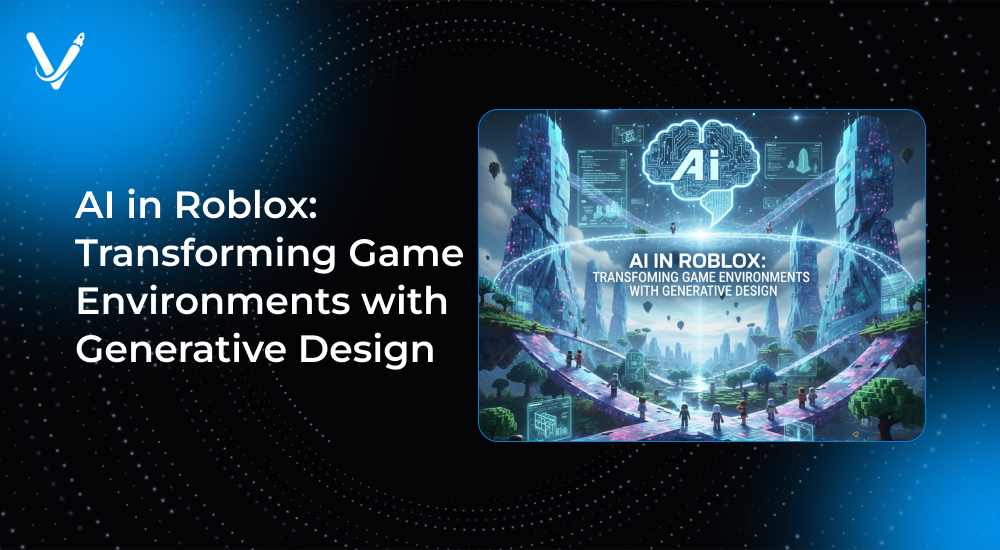AI in Roblox: Transforming Game Environments with Generative Design


- Nov 10, 2025



Key Takeaways
Artificial Intelligence has evolved from a buzzword into a transformative force shaping how games are designed, developed, and played. In the realm of Roblox, AI is not just enhancing graphics or automating simple scripts — it’s redefining how worlds come to life.
Developers are leveraging generative design, a process where algorithms and machine learning models help construct dynamic environments, architecture, terrains, and even character behavior.
In traditional Roblox Studio workflows, building vast maps, interactive NPCs, or adaptive quests demanded countless hours of manual design. But AI changes that. Through generative design tools, procedural scripting, and external AI APIs, creators can automate complex world-building processes while maintaining creative control.
This article dives deep into how AI and generative design are reshaping Roblox game environments — exploring workflows, APIs, technical integration patterns, and the emerging ecosystem that empowers developers to craft immersive, intelligent, and scalable experiences.
Generative design is an iterative process powered by AI algorithms that autonomously generate creative assets or layouts based on defined constraints. In Roblox, it means using code and data-driven models to produce environments, structures, and interactions that evolve dynamically.
Unlike traditional static design, where each object and scene is manually created, generative design allows developers to define the rules instead of the results. The algorithm handles the rest — constructing assets that adapt to scale, terrain, or gameplay needs.
Generative systems in Roblox typically revolve around four major principles:
These principles mirror the logic behind AI-powered systems like OpenAI Codex or generative art networks — but within Roblox Studio, they merge seamlessly with Lua scripting and the physics engine to produce intelligent outcomes.
At its heart, Roblox uses Lua, a lightweight and flexible scripting language. AI integration begins here. Developers can write Lua scripts that interact with data-driven systems, generate procedural assets, or respond to machine learning model outputs.
Example:
A script could spawn vegetation density based on player exploration data.
local terrain = workspace.Terrain
local playerStats = {exploredZones = 10, activityLevel = 0.85}
local function generateForest(zoneCount, activity)
local density = math.clamp(zoneCount * activity, 0.1, 1)
for i = 1, density * 200 do
local tree = Instance.new("Part")
tree.Shape = Enum.PartType.Cylinder
tree.Size = Vector3.new(2, math.random(20, 40), 2)
tree.Position = Vector3.new(math.random(-500, 500), 0, math.random(-500, 500))
tree.BrickColor = BrickColor.new("Earth green")
tree.Parent = workspace
end
end
generateForest(playerStats.exploredZones, playerStats.activityLevel)
This simple logic can evolve into AI-driven systems that automatically analyze in-game behavior to generate forests, cities, or dungeons dynamically.
Generative AI models can be hosted externally (for example, OpenAI, Hugging Face, or custom TensorFlow/PyTorch services). Roblox’s HttpService allows developers to make secure REST API calls to these services.
For instance, an AI service can generate terrain maps, procedural textures, or dialogue responses.
local HttpService = game:GetService("HttpService")
local function getAIGeneratedTerrain(seed)
local payload = {seed = seed}
local response = HttpService:PostAsync(
"https://your-ai-server.com/generate-terrain",
HttpService:JSONEncode(payload),
Enum.HttpContentType.ApplicationJson
)
return HttpService:JSONDecode(response)
end
The AI server could use a Generative Adversarial Network (GAN) or Stable Diffusion-style model to create height maps, texture patterns, or layout blueprints, which Roblox then interprets to build terrain automatically.
This architecture separates computation-heavy AI workloads from Roblox Studio, keeping performance optimal while enabling limitless creative automation.
AI in Roblox isn’t limited to visual generation. Developers are embedding machine learning models that learn from player interactions, adapting the environment and challenges in real time.
For instance:
By analyzing behavioral data — movement heatmaps, success rates, or social interactions — AI systems craft personalized experiences that feel handcrafted yet are fully automated.
This approach bridges the gap between procedural content and player-centric storytelling, which historically required extensive manual scripting.
Roblox Studio’s Terrain API allows scripts to create detailed landscapes algorithmically. Combined with AI-generated heightmaps or noise patterns, developers can produce realistic environments instantly.
Example Workflow:
local terrain = workspace.Terrain
local heightMap = HttpService:GetAsync("https://your-ai-server.com/heightmap.png")
-- Assume you decode pixels to values (0–255)
for x = 1, 512 do
for z = 1, 512 do
local height = decodePixel(x, z)
terrain:FillBall(Vector3.new(x*2, height, z*2), 4, Enum.Material.Grass)
end
end
This process gives creators endless worlds where every new session feels unique.
Lighting plays a crucial role in immersion. With AI, developers can train models to predict optimal lighting setups for different moods — morning glow, cyberpunk night, or stormy ambiance.
Using trained datasets of lighting parameters, AI tools can recommend configurations for:
Developers can integrate these through an editor plugin that suggests or auto-applies presets.
local Lighting = game:GetService("Lighting")
local function applyLightingProfile(profile)
Lighting.Brightness = profile.brightness
Lighting.Ambient = Color3.fromRGB(profile.ambient.r, profile.ambient.g, profile.ambient.b)
Lighting.FogColor = Color3.fromRGB(profile.fog.r, profile.fog.g, profile.fog.b)
Lighting.FogEnd = profile.fogEnd
end
An AI backend can analyze environment metadata and push lighting presets dynamically, ensuring every generated scene feels coherent and emotionally consistent.
In large worlds, object placement can be tedious. AI-assisted object placement tools analyze terrain slope, material, and gameplay flow to automatically position trees, rocks, props, or structures.
Using Poisson disk sampling or Perlin noise, algorithms distribute assets naturally while maintaining performance thresholds.
For example:
This procedural placement maintains both realism and efficiency — the backbone of open-world Roblox experiences.
Imagine feeding architectural blueprints or layout prompts into an AI model that generates modular Roblox buildings. Generative design systems use grammar-based algorithms (like L-systems) or diffusion models to output 3D structural patterns.
Developers define:
AI then generates corresponding Lua code or model files.
local function createBuilding(floors, style)
local base = Instance.new("Part")
base.Size = Vector3.new(50, 2, 50)
base.Anchored = true
base.Position = Vector3.new(0, 1, 0)
base.BrickColor = BrickColor.new("Dark stone grey")
base.Parent = workspace
for i = 1, floors do
local floor = Instance.new("Part")
floor.Size = Vector3.new(50, 10, 50)
floor.Position = Vector3.new(0, 5 + (i * 10), 0)
floor.BrickColor = BrickColor.new("Medium stone grey")
floor.Parent = workspace
end
end
createBuilding(5, "modern")
Once integrated with AI model outputs, these scripts dynamically assemble complex cities, each unique yet structurally coherent.
One of the most groundbreaking evolutions is the introduction of AI-driven text interfaces within Roblox Studio — akin to coding copilots for world builders.
Developers can type natural language prompts like:
“Create a forest clearing with five tents, campfire lighting, and gentle fog.”
An AI plugin parses the prompt, converts it into structured Lua commands, and executes it inside Studio.
This workflow typically involves:
Such systems significantly lower the barrier for world creation while maintaining full developer control over refinement and customization.
Developers can collect gameplay data through DataStoreService — tracking player paths, interactions, or environment preferences. These logs feed into machine learning pipelines that train models on optimal layout or design patterns.
Collected data includes:
Once anonymized and aggregated, this dataset can teach AI systems what players find engaging or navigable.
The training pipeline often includes:
For example, a Reinforcement Learning agent could learn to spawn enemies or rewards where player attention wanes, keeping engagement high across sessions.
AI-generated content must respect Roblox’s community guidelines. Developers can implement content filters, moderation models, and review workflows to prevent unwanted outputs.
Generative systems should also include:
By combining automation with human oversight, developers achieve both innovation and responsibility.
Roblox Cloud APIs and the upcoming Open Cloud services offer opportunities to streamline AI pipelines. Developers can manage data storage, compute tasks, and AI inferences without leaving the Roblox ecosystem.
Example:
This continuous cycle of generation, testing, and feedback enables rapid iteration — essential for maintaining engaging live experiences.
NPCs (Non-Player Characters) define the soul of many Roblox experiences. Generative AI makes them lifelike — capable of procedural movement, conversational intelligence, and emotional variation.
Developers are using behavior trees enhanced with ML predictions or external LLMs for dialogue generation.
For instance, an NPC can respond contextually:
Player: “Where can I find the ancient temple?”
NPC: “Follow the glowing trees north of the waterfall — the temple hides beyond the cliffs.”
This reply could be generated dynamically by a GPT-like model hosted externally, filtered through custom prompts, and sent back to Roblox via HTTP calls.
Such integration creates adaptive storytelling where every interaction feels unique — a massive leap beyond pre-scripted lines.
Several experimental and commercial projects showcase how AI reshapes Roblox development:
These implementations not only boost development efficiency but also elevate creative storytelling and replayability.
As Roblox continues expanding its AI initiative (like Code Assist and generative 3D models), generative design is moving toward native integration.
Predicted evolutions include:
For developers, this means shorter iteration cycles, scalable creativity, and exponential productivity. Instead of writing thousands of lines of Lua for asset placement, teams can focus on core mechanics and narrative depth.
While this piece is developer-centric, it’s worth noting that generative AI also impacts monetization. By reducing development time and expanding asset diversity, creators can produce more games, faster, and experiment with styles or mechanics rapidly.
AI can also analyze game economy balance, simulate market reactions, and help design in-game reward systems optimized for retention and revenue.
Developers who master AI workflows gain a competitive edge — becoming capable of building vast, dynamic worlds without massive teams.
Despite its promise, AI integration in Roblox introduces technical and operational challenges:
With thoughtful implementation, these challenges become manageable stepping stones toward richer game experiences.
AI and generative design are not futuristic add-ons — they are becoming the new foundation of game creation inside Roblox.
Through procedural terrain, intelligent NPCs, adaptive lighting, and automated world generation, developers can now build massive, immersive experiences once limited to large studios.
Generative AI turns code into creativity, empowering every Roblox developer to experiment, iterate, and deploy faster. As these tools mature, we move closer to a world where developers describe their imagination — and the AI brings it to life in real time.
For creators and studios aiming to harness this future, collaboration with experts in AI-driven development can make all the difference.
Vasundhara Infotech specializes in AI integration, generative game design, and immersive 3D development, helping innovators build the next generation of Roblox experiences.
Reach out to us today — and let’s craft worlds where imagination and intelligence merge seamlessly.
How does Vasundhara Infotech help with Roblox AI projects?
Vasundhara Infotech provides tailored AI and game development services — integrating generative design tools, custom APIs, and intelligent systems to elevate your Roblox game environments.
Copyright © 2025 Vasundhara Infotech. All Rights Reserved.